Chi Omega Fountain
Introduction
Text-to-speech Audio
Dedicated on April 23, 1955, the Chi Omega Fountain stands at the western edge of Jayhawk Boulevard as a memorial to alumni of KU's Lambda Chapter. The fountain project began in October of 1952 as part of the sorority chapter’s 50th anniversary. About half of the cost of the fountain came from students and alumni. The limestone fountain has become a prominent campus landmark, given its location at the junction of Naismith Drive and Jayhawk Boulevard. The panels of the fountain were crafted by KU student James L. Bass and feature characters from Greek mythology.
Images
Chi Omega Fountain
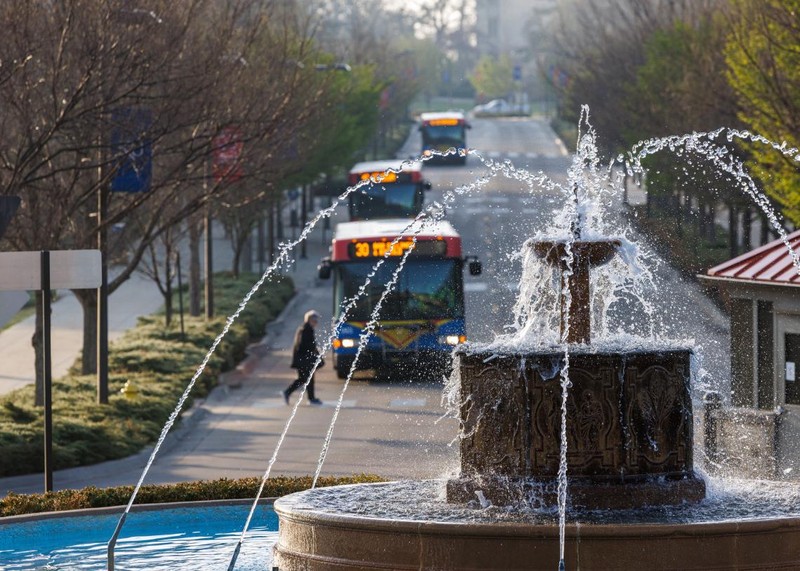
Chi Omega Fountain dedication on April 23, 1955
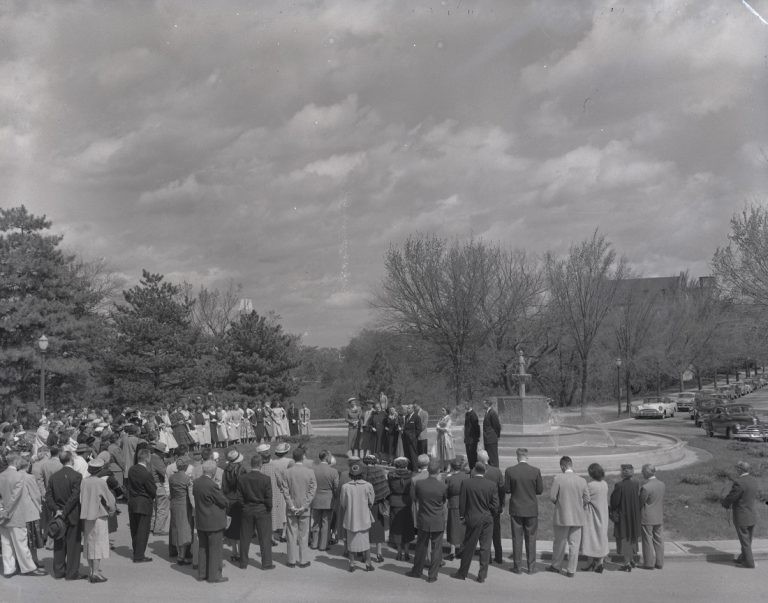
Working on the Chi Omega Fountain
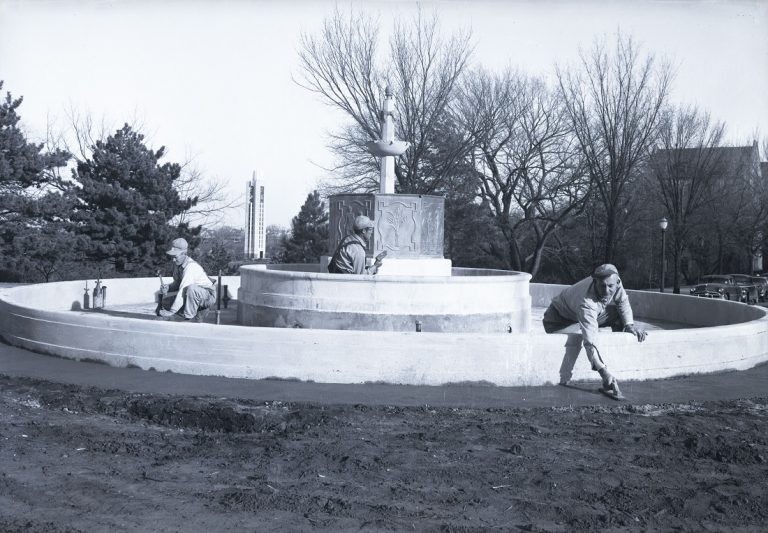
Man playing guitar to woman in front of Chi Omega Fountain, 1969-70
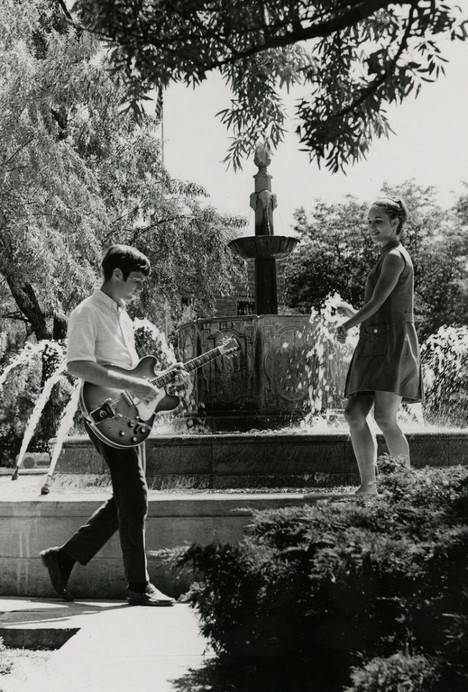
Students at the Chi Omega Fountain
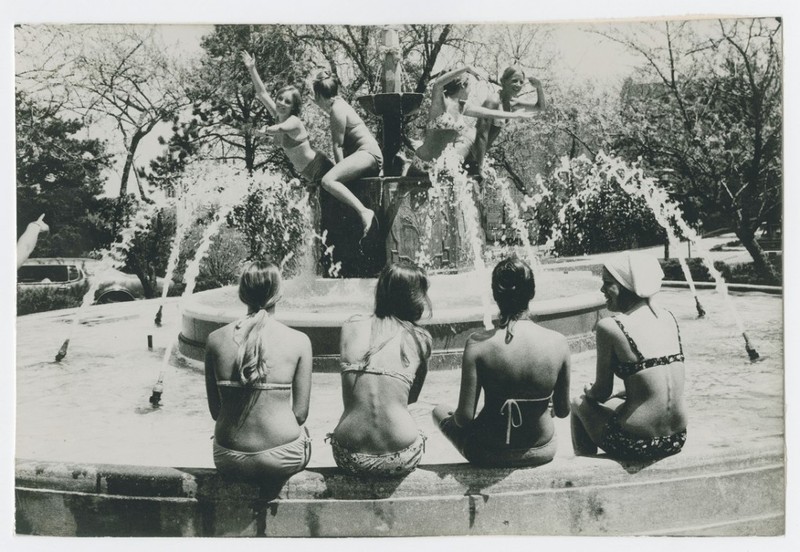
Backstory and Context
Text-to-speech Audio
The Chi Omega Fountain was dedicated on April 23, 1955, with 300 people in attendance. Speaking at the dedication ceremony Chancellor Franklin D. Murphy extolled the fountain’s virtues, “It represents another step in the beautification of the naturally beautiful K.U. campus. The fountain shows the University is interested not only in utilitarian things but in beauty as well.” The chance to design the fountain’s panels had been won in a contest by KU fine arts student James L. Bass.
Bass won the right to design the eight relief plaques, and $100, with a Grecian design depicting the Eleusinian myth. The Eleusinian myth, or the story of Persephone and Hades, is depicted with four main panels and the same number alternating between them. The alternating panels respectively depict an owl, a pomegranate, a sheaf of wheat, and a cluster of carnations. The main panels depict Hades, Demeter, and Persephone adorned with a crown and flowers, and a contrasting Persephone as Queen of the Dead.
The basin of the fountain was made with Indiana limestone, a structure inspired by a similar fountain from Northumberland, England because it “ harmonized with the Chi Omega house which is of English design.” The fountain was fabricated by Erkin Studios in New York. Out of the fountain’s $11,800 cost, about $5,000 was sourced from students, alumni, and friends of Chi Omega. The rest of the cost was paid by the Elizabeth M. Watkin’s fund through the KU Endowment.
In the decades that followed its dedication, the Chi Omega Fountain has become a common reference point for students and alumni given its location at the western entrance to Jayhawk Boulevard. The fountain usually offers a place of peaceful reflection and relaxation, but it has also been the center of numerous campus pranks. The waters of the fountain have met dye, soap, even a catfish. However one decides to use the fountain, it remains a symbol of KU’s active student life, both as a work of architecture and point of student tradition.
Cite This Entry
Trowbridge, David and Levi Cromwell. "Chi Omega Fountain." Clio: Your Guide to History. September 1, 2023. Accessed March 27, 2025. https://theclio.com/tour/2625/18
Sources
“Chi Omega Fountain.” KU Directory of Places, https://places.ku.edu/fountain/chi-omega-fountain. Accessed 06/25/23.
Donnelly, Caitlin, Melissa Kleinschmidt, and Abbey Ulrich. 2017. “Throwback Thursday: Dedication Edition.” In Inside Spencer: The KSRL Blog. KU Libraries: Kenneth Spencer Research Library. https://blogs.lib.ku.edu/spencer/throwback-thursday-dedication-edition/.
National Museum of the American Indian, Smithsonian Institution. “Smithsonian Learning Lab Resource: Chi Omega Fountain, (sculpture).” Smithsonian Learning Lab, Smithsonian Office of Educational Technology, 3 Nov. 2015, https://learninglab.si.edu/q/r/278552
Roe, Sasha. 2009. “Chi Omega Fountain central to many KU traditions.” Lawrence Journal-World, August 18, 2009. https://www2.ljworld.com/news/2009/aug/18/chi-omega-fountain-central-many-ku-traditions/.
https://places.ku.edu/fountain/chi-omega-fountain
https://blogs.lib.ku.edu/spencer/tag/chi-omega-fountain/
https://blogs.lib.ku.edu/spencer/tag/chi-omega-fountain/
https://blogs.lib.ku.edu/spencer/tag/chi-omega-fountain/
https://blogs.lib.ku.edu/spencer/tag/chi-omega-fountain/

